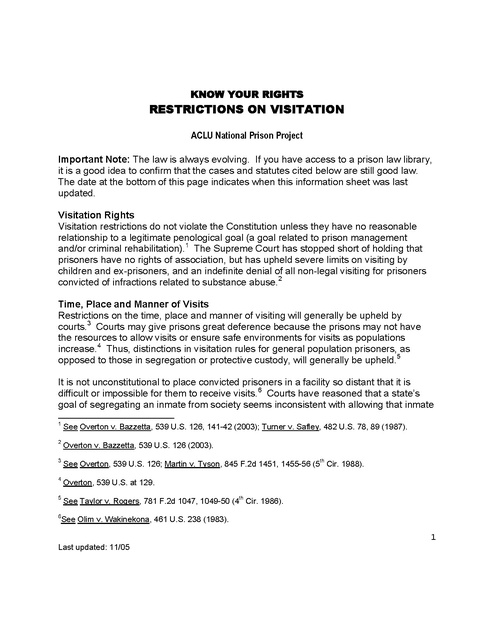Visiting Rights 2005
Download original document:

Document text

Document text
This text is machine-read, and may contain errors. Check the original document to verify accuracy.
KNOW YOUR RIGHTS RESTRICTIONS ON VISITATION ACLU National Prison Project Important Note: The law is always evolving. If you have access to a prison law library, it is a good idea to confirm that the cases and statutes cited below are still good law. The date at the bottom of this page indicates when this information sheet was last updated. Visitation Rights Visitation restrictions do not violate the Constitution unless they have no reasonable relationship to a legitimate penological goal (a goal related to prison management and/or criminal rehabilitation).1 The Supreme Court has stopped short of holding that prisoners have no rights of association, but has upheld severe limits on visiting by children and ex-prisoners, and an indefinite denial of all non-legal visiting for prisoners convicted of infractions related to substance abuse.2 Time, Place and Manner of Visits Restrictions on the time, place and manner of visiting will generally be upheld by courts.3 Courts may give prisons great deference because the prisons may not have the resources to allow visits or ensure safe environments for visits as populations increase.4 Thus, distinctions in visitation rules for general population prisoners, as opposed to those in segregation or protective custody, will generally be upheld.5 It is not unconstitutional to place convicted prisoners in a facility so distant that it is difficult or impossible for them to receive visits.6 Courts have reasoned that a state’s goal of segregating an inmate from society seems inconsistent with allowing that inmate 1 See Overton v. Bazzetta, 539 U.S. 126, 141-42 (2003); Turner v. Safley, 482 U.S. 78, 89 (1987). 2 Overton v. Bazzetta, 539 U.S. 126 (2003). 3 See Overton, 539 U.S. 126; Martin v. Tyson, 845 F.2d 1451, 1455-56 (5th Cir. 1988). 4 Overton, 539 U.S. at 129. 5 See Taylor v. Rogers, 781 F.2d 1047, 1049-50 (4th Cir. 1986). 6 See Olim v. Wakinekona, 461 U.S. 238 (1983). 1 Last updated: 11/05 access to visitors.7 The Constitution does not require contact visits (prison visitations that permit visitors and inmates to have a limited degree of contact without a glass-barrier)8 or conjugal visits (unsupervised visits between inmates and their spouses, usually over a weekend, which permit sexual contact)9 either for convicted prisoners or for pre-trial detainees. Courts have been more sympathetic in cases involving county jails with extremely limited visiting opportunities or oppressive conditions.10 Who May Visit Courts have upheld rules restricting visitors.11 Visitors may be required to get prior approval for visits.12 Close family members including children may be barred from visiting based not only on good cause, such as a past attempt to smuggle contraband,13 but also by facility regulation.14 Prisoners are entitled to receive visits from clergy and religious advisers, but prison officials have considerable control over how these rights are exercised.15 Legal Visits All inmates have a right to legal visits, but the Sixth Amendment does not require full and unfettered contact between an inmate and his or her attorney in all circumstances. If the state denies a contact visit with a lawyer, however, it must provide a rationale.16 7 Overton, 539 U.S. at 141 (Thomas, J., concurring). 8 See Block v. Rutherford, 468 U.S. 576, 588-89 (1984). 9 See Champion v. Artuz, 76 F.3d 483, 486 (2nd Cir. 1996). 10 See Morrow v. Harwell, 768 F.2d 619, 626-27 (5th Cir. 1985). 11 See Overton, 539 U.S. at 129-31; Smith v. Coughlin, 748 F.2d 783, 788-89 (2nd Cir. 1984). 12 See Ramos v. Lamm, 639 F.2d 559, 580-81 (10th Cir. 1980). 13 See Robinson v. Palmer, 841 F.2d 1151, 1156 (D.C. Cir. 1988). 14 Overton, 539 U.S. at 129-31. 15 See Reimers v. Oregon, 863 F.2d 630, 631-32 (9th Cir. 1988). 16 See Mann v. Reynolds, 46 F.3d 1055, 1060-61 (10th Cir. 1995). 2 Last updated: 11/05 Additionally, prisons and jails must provide reasonable schedules and facilities for visits by attorneys and paralegals.17 Generally, prisoners must be granted confidentiality in their legal visits.18 New laws passed in the wake of September 11th, however, have placed some limitations on the privilege of confidential communications with an attorney. If the Attorney General believes there is "reasonable suspicion" that a person in custody "may" use communications with attorneys or their agents "to further or facilitate acts of terrorism," the Justice Department "shall … provide appropriate procedures for the monitoring or review of communications between that inmate and attorneys or attorneys' agents who are traditionally covered by the attorney-client privilege." 28 C.F.R. § 501.3(d). In such a case, the Justice Department must either provide written notice to the inmate and attorneys involved or get court authorization to monitor the communications. Id. A Justice Department privilege team will then review the information to determine whether it relates to imminent acts of violence or terrorism. Information that the privilege team determines to relate to imminent acts of violence or terrorism can be disclosed. Information that does not relate to imminent acts of violence or terrorism cannot be disclosed unless a federal judge approves the disclosure. 28 C.F.R. § 501.3(d)(3). These regulations are being challenged by a number of organizations that believe them to be unconstitutional. 17 See Procunier v. Martinez, 416 U.S. 396, 419 (1974), overruled on other grounds by Thornburgh v. Abbott, 490 U.S. 401 (1989); Negron v. Wallace, 436 F.2d 1139, 1144-45 (2nd Cir. 1971). 18 See Johnson-El v. Schoemehl, 878 F.2d 1043, 1051-52 (8th Cir. 1989). 3 Last updated: 11/05





